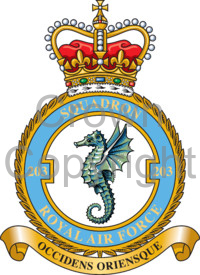No 203 Squadron, Royal Air Force: Difference between revisions
Jump to navigation
Jump to search
Knorrepoes (talk | contribs) m (Text replacement - "The Badge " to "The badge ") |
Knorrepoes (talk | contribs) m (Text replacement - "{{media}}↵" to "") |
||
| Line 13: | Line 13: | ||
===Origin/meaning=== | ===Origin/meaning=== | ||
When stationed in the Persian Gulf the Personnel of the Squadron noticed many Seahorses on the beach and adopted this design as a Badge. The Motto translates as "West and East". The badge was granted in February 1937. | When stationed in the Persian Gulf the Personnel of the Squadron noticed many Seahorses on the beach and adopted this design as a Badge. The Motto translates as "West and East". The badge was granted in February 1937. | ||
[[Literature]]: Image from Defence Brand Portal Ministry of Defence | [[Literature]]: Image from Defence Brand Portal Ministry of Defence | ||
Revision as of 07:29, 6 April 2023
| Heraldry of the World |
| British heraldry portal Civic heraldry of the United Kingdom |
|
NO 203 SQUADRON, ROYAL AIR FORCE
History: Formed at Eastchurch in August 1914 as No 3 Squadron, Royal Naval Air Service. Becoming on 1 April 1918 No 203 Squadron, RAF.
Official blazon
Badge: A winged sea-horse proper.
Motto: Occidens oriensque.
Origin/meaning
When stationed in the Persian Gulf the Personnel of the Squadron noticed many Seahorses on the beach and adopted this design as a Badge. The Motto translates as "West and East". The badge was granted in February 1937.
Literature: Image from Defence Brand Portal Ministry of Defence


